Canton may refer to:

Frederick William I, known as the "Soldier King", was King in Prussia and Elector of Brandenburg from 1713 until his death in 1740, as well as Prince of Neuchâtel. Frederick William instituted major military reforms, and expanded the army to new limits. He also made efforts to reduce corruption in his state and centralized his authority during his 27 years reign, cementing Prussia as a regional power. His other notable decisions would be the selling of Prussian overseas colonies and the foundation of the Canton system, as well as the conquest of the port of Stettin. He was succeeded by his son, Frederick the Great.
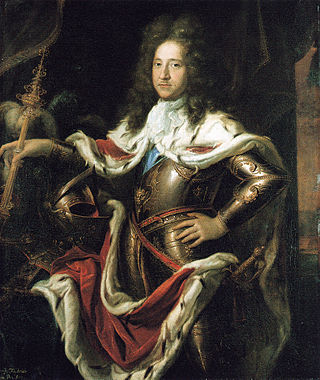
Frederick I, of the Hohenzollern dynasty, was Elector of Brandenburg (1688–1713) and Duke of Prussia in personal union (Brandenburg-Prussia). The latter function he upgraded to royalty, becoming the first King in Prussia (1701–1713). From 1707 he was in personal union the sovereign prince of the Principality of Neuchâtel.

The Potsdam Giants was the name given to Prussian infantry regiment No 6. The regiment was composed of taller-than-average soldiers, and was founded in 1675. It was eventually dissolved in 1806, after the Prussians were defeated by Napoleon. Throughout the reign of the Prussian king Friedrich Wilhelm I of Prussia (1688–1740), the unit was known as the "Potsdamer Riesengarde" in German, but the Prussian population quickly nicknamed them the Lange Kerls.

Prussia was a German state located on most of the North European Plain, also occupying southern and eastern regions. It formed the German Empire when it united the German states in 1871. It was de facto dissolved by an emergency decree transferring powers of the Prussian government to German Chancellor Franz von Papen in 1932 and de jure by an Allied decree in 1947. For centuries, the House of Hohenzollern ruled Prussia, expanding its size with the Prussian Army. Prussia, with its capital at Königsberg and then, when it became the Kingdom of Prussia in 1701, Berlin, decisively shaped the history of Germany.

The Battle of Zorndorf, during the Seven Years' War, was fought on 25 August 1758 between Russian troops commanded by Count William Fermor and a Prussian army commanded by King Frederick the Great. The battle was tactically inconclusive, with both armies holding their ground and claiming victory. The site of the battle was the Prussian village of Zorndorf. During the battle, Frederick famously took a regimental standard and led an attack himself, rallying his troops.
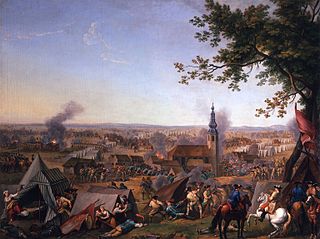
The Battle of Hochkirch took place on 14 October 1758, during the Third Silesian War. After several weeks of maneuvering for position, an Austrian army of 80,000 commanded by Lieutenant Field Marshal Leopold Josef Graf Daun surprised the Prussian army of 30,000–36,000 commanded by Frederick the Great. The Austrian army overwhelmed the Prussians and forced a general retreat. The battle took place in and around the village of Hochkirch, 9 kilometers (6 mi) east of Bautzen, Saxony.

Kurt Christoph, Graf von Schwerin was a Prussian Generalfeldmarschall, one of the leading commanders under Frederick the Great.

Cantonists were underage sons of conscripts in the Russian Empire. From 1721 on they were educated in special "cantonist schools" for future military service. The cantonist schools and the cantonist system were eventually abolished in 1857, following public and international criticism and the Russian defeat in the Crimean War.

Antoine Pesne was a French-born court painter of Prussia. Starting in the manner of baroque, he became one of the fathers of rococo in painting. His work represents a link between the French school and the Frederican rococo style.

The Royal Prussian Army served as the army of the Kingdom of Prussia. It became vital to the development of Prussia as a European power.

Anton Wilhelm von L'Estocq was a Prussian cavalry general best known for his command of the Prussian troops at the Battle of Eylau.

Conscription in the Russian Empire was introduced by Peter I of Russia. The system was called "conscript obligation".

The Royal Prussian Army was the principal armed force of the Kingdom of Prussia during its participation in the Napoleonic Wars.
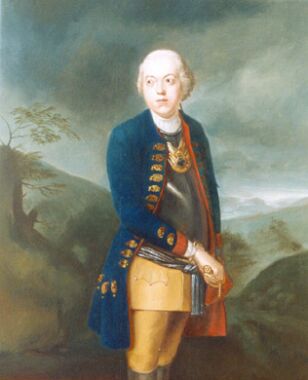
Hans Christoph Friedrich Graf von Hacke was a Prussian General and Commandant of Berlin. The Hackescher Markt in Berlin is named after him.

The French Royal Army was the principal land force of the Kingdom of France. It served the Bourbon dynasty from the reign of Louis XIV in the mid-17th century to that of Charles X in the 19th, with an interlude from 1792 to 1814 and another during the Hundred Days in 1815. It was permanently dissolved following the July Revolution in 1830. The French Royal Army became a model for the new regimental system that was to be imitated throughout Europe from the mid-17th century onward. It was regarded as Europe's greatest military force and the most powerful armies in the world for much of its existence.

The Prussian Reform Movement was a series of constitutional, administrative, social, and economic reforms early in 19th-century Prussia. They are sometimes known as the Stein–Hardenberg Reforms, for Karl Freiherr vom Stein and Karl August von Hardenberg, their main initiators. German historians, such as Heinrich von Treitschke, saw the reforms as the first steps towards the unification of Germany and the foundation of the German Empire before the First World War.
The 13 Cuirassier regiments of Old Prussia were formed in the mid-17th to mid-18th centuries, and formed the basis of Frederick the Great's vaunted cavalry.
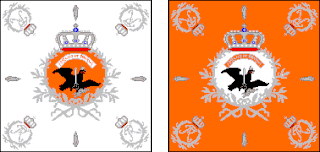
The 1st Prussian Infantry Regiment was a line infantry regiment of the Old Prussian Army which had initially formed part of the Prussian Life Guard, but later transferred to the line. After notably serving in the War of the Austrian Succession and Seven Years' War, the regiment was demolished following the Battle of Auerstadt. A small part of the regiment went on to help form the famed 8th Life Infantry Regiment, which in turn would serve notably till its disbandment after World War I.
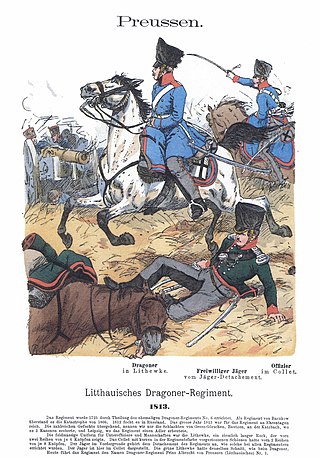
1st Lithuanian Dragoon Regiment was a Prussian Lithuanian dragoon regiment of the Royal Prussian Army. The regiment was formed in 1717 and disbanded in 1919. This regiment was one of the eldest in the whole Prussian army.